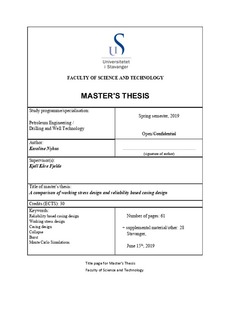| dc.contributor.advisor | Fjelde, Kjell Kåre | |
| dc.contributor.author | Nyhus, Karoline | |
| dc.date.accessioned | 2019-12-19T12:25:15Z | |
| dc.date.available | 2019-12-19T12:25:15Z | |
| dc.date.issued | 2019-06-15 | |
| dc.identifier.uri | http://hdl.handle.net/11250/2634142 | |
| dc.description | Master's thesis in Petroleum engineering | nb_NO |
| dc.description.abstract | Working stress design is the most common design method used on the Norwegian continental shelf and its simplicity makes it easy to understand. However, other methods as the reliability based design gives a different view on the casing design and gets more attractive as the wells that are being drilled are getting more complex. Reliability based design gives the opportunity to quantify the risk of the design and one of the outputs from this method is the probability of failure. This means that we get a number on how safe our design is and that makes it possible to do a risk assessment as well. Even though reliability based design is a more complex method and need more input data, compared to the working stress design, the results from the simulations are noticeable.
A casing grade selection was performed for a 13 3/8” intermediate section based on WSD and then on RBD. The loads considered are burst and collapse.
A comparison between the different burst models showed that the API model and the Klever-Stewart rupture limit model had the same spread of data and the API ad-hoc had the largest spread out of the models considered. Since the burst simulation take the rupture limits into account, the Klever-Stewart model was chosen as it seemed to be a the more suitable model for our purposes. Klever-Stewart is also the recommended rupture limit model according to API 5C3 as well.
RBD was performed with the use of Monte Carlo simulations in MATLAB. The simulations showed that RBD4 and RBD5, with Klever-Stewart rupture limit as the strength model, that a casing grade equal to N80 and K55 was sufficient to meet our requirements for a high consequence failure. On the other hand, WSD showed that a grade equal to P110 was necessary when considering the safety factor requirements from NORSOK D-010.
As for the collapse simulation, the API model was used as the strength model. RBD4 and RBD5 showed that K55 was sufficient to meet our target probability both for a low and high consequence failure. However the WSD showed that a grade equal to L80 was necessary to meet the NORSOK requirements regarding the safety factor.
The overall result was that the RBD method gave the opportunity to choose a lower casing grade than the WSD. However, the RBD method is more complex and needs more input data.
As RBD is based on the stochastic nature of the variables, distribution for each variable was taken into account. Parameters as mean and standard deviation for different input parameters like e.g. OD, thickness, yield and model error were found in the API 5C3, however some assumptions were made when data was not available. As for the load calculations, the worst case scenario was considered for the RBD4 and WSD, however subjective assumption was added for the RBD5.
The overall conclusion is that RBD4 allows you to choose a lower casing grade than WSD. RBD5 gives is less conservative than RBD4 and gives an even lower grade, however more relaxed assumptions were made for RBD5 where the uncertainty in the load was included. | nb_NO |
| dc.language.iso | eng | nb_NO |
| dc.publisher | University of Stavanger, Norway | nb_NO |
| dc.relation.ispartofseries | Masteroppgave/UIS-TN-IEP/2019; | |
| dc.rights | Navngivelse 4.0 Internasjonal | * |
| dc.rights.uri | http://creativecommons.org/licenses/by/4.0/deed.no | * |
| dc.subject | petroleumsteknologi | nb_NO |
| dc.subject | petroleum engineering | nb_NO |
| dc.subject | boring | nb_NO |
| dc.subject | drilling | nb_NO |
| dc.subject | Burst | nb_NO |
| dc.subject | Monte Carlo Simulations | nb_NO |
| dc.subject | boreteknologi | nb_NO |
| dc.subject | drilling technology | nb_NO |
| dc.subject | well engineering | nb_NO |
| dc.subject | reliability based design | nb_NO |
| dc.subject | working stress design | nb_NO |
| dc.subject | casing design | nb_NO |
| dc.subject | collapse | nb_NO |
| dc.title | A comparison of working stress design and reliability based casing design | nb_NO |
| dc.type | Master thesis | nb_NO |
| dc.subject.nsi | VDP::Technology: 500::Rock and petroleum disciplines: 510::Petroleum engineering: 512 | nb_NO |

